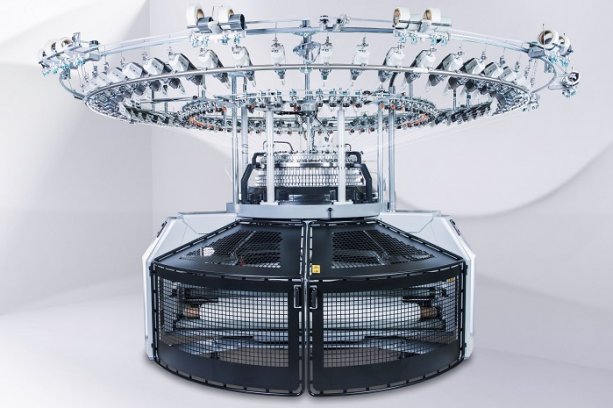
Circular knitting captures the mattress market
'Stay a winner: With Mayer & Cie.' is the Albstadt-based circular knitting machine manufacturer’s slogan at this year’s ITMA in Barcelona.

9th May 2019
Knitting Industry
|
Albstadt

Sebastian Mayer, Marcus Mayer and Benjamin Mayer. © Mayer & Cie.
Stay a winner: With Mayer & Cie. is the Albstadt-based circular knitting machine manufacturer’s slogan at this year’s ITMA in Barcelona. Four of the five machines on show at the Mayer & Cie. (MCT) stand will have a clear sports orientation.
These include MJ 3.2 E, a single jersey machine for body mapping; the OVJA 1.1 EETT, the specialist in knitted sports and leisure footwear; the Spinit 3.0 E, which comes with new functions and can now process polyester; and the new OVJA 2.4 EM mattress machine.
ITMA machine ‘number five’ is the only one with no special sports connection but it is very much in line with the company’s innovative tradition, the company reports. The prototype on show puts a tried and trusted process to a very modern use – with attractive benefits for customers.
“We see a great deal of potential in sports- and leisurewear, so the newly developed machines we are presenting at the ITMA are mainly in that area,” said Mayer & Cie. CEO Marcus Mayer. “Current market studies underscore this view. According to Morgan Stanley, an annual average growth of 7% is to be expected till 2021 in this segment.”
“Body mapping is one of the biggest trends in sportswear,” explained Marcus Mayer. “During sporting activity perspiration is greater in certain parts of the body than in others. Body mapping takes this factor into account by means of light and moisture-repellent areas.”

The new body mapping machine MJ 3.2. © Mayer & Cie.
From the textile perspective, body mapping is a kind of mesh fabric with a central characteristic: the ground thread is usually thinner than the plating thread, but also can be used up to the same thickness. Supplying an elastomeric yarn at the ground or the plating thread provides for the required elasticity. In body mapping, the plating thread in combination with the ground thread of a different colour is responsible for the characteristic colouring.
The new MJ 3.2 E is Mayer & Cie.’s high-quality option for body-mapped fabrics. Unlike the Relanit 1.6 E, the previous option for body mapping, the MJ 3.2 E can process elastomeric yarns.
Since the 2012 Olympics, sports shoes have been known to be available with knitted fabric uppers. All electronic Jacquard machines in the Mayer & Cie. OVJA range score points for productivity and short set-up times for shoe uppers. The main trend is toward multi-colour spacer fabrics with 3D effects, realised by lay-in yarns.
The new Mayer & Cie. OVJA 1.1 EETT, a multi-colour Jacquard machine with double electronics, produces a wide range of patterns. This includes a variety of hole structures with bigger and smaller holes, thanks to double transfer.
Regeneration and peak sporting performance are known to be closely associated. That is why for Mayer & Cie., the OVJA 2.4 EM fits neatly into the ITMA concept. “With this machine we offer our customers outstanding productivity along with variety of patterns and ease of use,” said Marcus Mayer. It is the youngest member of the family of fully electronic OVJA machines, producing up to 30 kg of fabric per hour, with a speed factor of 950.

Mayer & Cie. presents OVJA 2.4 EM productive mattress machine. © Mayer & Cie.
In general, it produces fabric weights of between 200 and 300 grams per square metre but can also reach more than 500 grams per square metre.
The Spinit 3.0 E, in series production since the end of 2018, is part of Mayer & Cie.’s focus on sport at the trade fair. With Enhanced Performance, the circular knitting machine manufacturer has further developed its multiple award winning machine so that the spinning and knitting machine can now process polyester and athleisure and sportswear can also be produced on the Spinit 3.0 E. Speed is a further improvement; the latest model is, depending on the knitted structure, up to 20% faster, in processing cotton as well as polyester.
“Digitisation, which we are taking forward throughout the company, also improves machine performance,” explained Marcus Mayer. “With Digital Spinit, we are presenting attractive innovations for all three central aspects of any machine – Create, Operate and Control.”

Business intelligence for the fibre, textiles and apparel industries: technologies, innovations, markets, investments, trade policy, sourcing, strategy...
Find out more